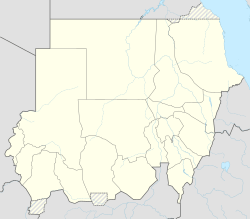Jebel Barkal facts for kids
|
جبل بركل
|
|

Jebel Barkal is a small mountain, 98 meters tall
|
|
| Alternative name | Gebel Barkal |
|---|---|
| Location | Karima, Northern State, Sudan |
| Region | Nubia |
| Coordinates | 18°32′12″N 31°49′42″E / 18.53667°N 31.82833°E |
| Type | Sanctuary |
Jebel Barkal (also called Gebel Barkal) is a small mountain in Sudan. It's found in the town of Karima, in the Northern State. This mountain sits on a big bend of the Nile River in a region known as Nubia.
Jebel Barkal is 98 meters (about 321 feet) tall and has a flat top. Long ago, it was an important landmark. Traders used it to find their way on a busy route. This route connected central Africa, Arabia, and Egypt. The mountain marked a good spot to cross the mighty Nile River. In 2003, Jebel Barkal and the ancient city of Napata (which is right next to it) became World Heritage Sites. This special title was given by UNESCO.
A Look Back: Jebel Barkal's History
Around 1450 BCE, the Egyptian Pharaoh Thutmose III expanded his empire. He reached this area and saw Jebel Barkal as the southern edge of his lands. He led campaigns near the city of Napata. About 300 years later, Napata became the capital of an independent kingdom called Kush.
Later, Piye, a Nubian king from the 25th Dynasty, made the Temple of Amun much bigger. He also put up his Year 20 Victory stela inside the temple. This stela was a stone slab that told about his victories.
Exploring the Ancient Ruins
Around Jebel Barkal, you can find the remains of at least 13 temples and 3 palaces. European explorers first wrote about these ruins in the 1820s. In 1862, an Egyptian officer found five important inscriptions. These were from a time called the Third Intermediate Period. He sent them to the Cairo Museum.
However, serious scientific digs didn't start until 1916. A team from Harvard University and the Museum of Fine Arts in Boston worked together. They carefully uncovered parts of the ancient city.
In the 1970s, a team from the University of Rome La Sapienza continued the explorations. Another team from the Boston Museum joined them in the 1980s. Even today, local people consider the larger temples, like the Temple of Amun, to be sacred and important.
Images for kids
-
The last standing pillars of Napata's temple of Amun at the foot of Jebel Barkal
-
Lion-headed God Appademak with Pharaoh Taharqa (right) in the Jebel Barkal Temple of Mut.
-
Senkamanisken slaying enemies in front of God Amun, at Jebel Barkal (pylon of building B 700, west of the main temple).
-
Colossal statue of King Aspelta from the Temple of Amun, Jebel Barkal. Boston Museum of Fine Arts.
-
The Stele of Piye was discovered in Jebel Barkal. Cairo Museum
-
The Stele of Tantamani. Cairo Museum
-
Golden Bracelet found in the tomb of a member of the Royal Family in Gebel Barkal. Meroic period, 250-100 BCE
-
Barque stand from Temple B700 showing Atlanersa holding up the heavens, now in the Museum of Fine Arts in Boston
See also
 In Spanish: Gebel Barkal para niños
In Spanish: Gebel Barkal para niños





















